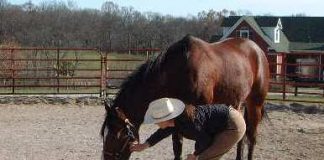Q: What do you do if when you cue your horse to canter he acts like he’s going to buck? Should you keep cueing or stop the canter cue and allow him to relax?
Cantering requires the horse to round his back and move in an athletic way to push off and into the faster gait. This can make any back or rib pain or saddle-fit problem more pronounced, causing the horse not to want to move into the canter.
Always rule out pain first by having the horse examined by a chiropractor that’s also a licensed equine veterinarian. Many times horses deemed “cold backed” are the same ones that threaten to buck at the canter—they’re experiencing some pain that may be lessened with chiropractic care.
Some horses simply prefer to not canter—it’s a lot of hard work! Even if the bucking at the canter started for a physical reason, you may still have to address it as a training problem after all physical issues are corrected.
When the horse crow-hops or bucks, the rider usually pulls back on the reins in an effort to regain control. When you pull back on the reins, you give the horse the cue he wanted. To him, it feels like you’re asking him to slow down. Even if he only gets to rest for a second, it inadvertently rewards the threatening behavior.
The horse now associates his threat to buck with getting to stop. He has trained you. If you ask him to canter again, he will probably threaten to buck again, because it worked really well the last time.
Your best option is to urge the horse forward (knowing that he may offer to buck again). Don’t add emotion to the cue by whipping or over-cueing. Simply push the horse more forward into a hand-gallop, driving with your seat and legs, and keep your hands moving forward.
As soon as you feel the horse relax his back and come into a willing state, moving forward with relaxation, stop. When you allow him to slow after he has successfully cantered, you’ll be rewarding positive behavior.
For this strategy to work, you have to be a confident and skilled enough rider to move the horse forward and ride out a few bucks. If you’re worried about doing so, you should consult a more experienced rider or trainer to help—otherwise you may pull back unintentionally and teach your horse the wrong thing.
Julie Goodnight shares her lessons on her RFD-TV show, Horse Master (also online at tv.juliegoodnight.com), and through clinics and expos. Heidi Melocco (www.whole-picture.com) is a lifelong horsewoman, equine journalist, and photographer.
This article originally appeared in the May 2016 issue of Horse Illustrated magazine. Click here to subscribe!






